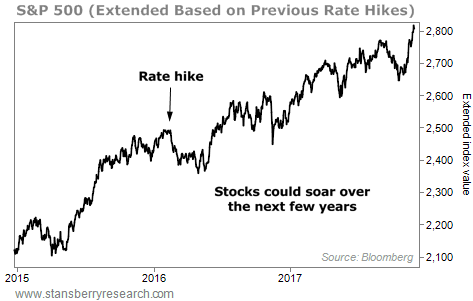 It’s got to be time to sell, right?
It’s got to be time to sell, right?
After all, stocks have been going up for nearly six years now – they’ve got to be near the end of their run… Right?
I disagree…
Don’t worry so much about where stocks have been – don’t drive by looking in the rear-view mirror. Instead, look ahead.
When I look ahead, I see plenty of room for stocks to run higher. Plenty of upside remains.
[ad#Google Adsense 336×280-IA]Today, I’ll show you one simple reason why this boom in stocks isn’t over yet.
Let me explain…
During the global financial crisis of 2007-2008, Ben Bernanke (the chairman of the Federal Reserve at the time) slashed interest rates to zero and promised extraordinary measures to get us out of the crisis.
My thesis since then has been that the Fed would keep interest rates lower than anyone could imagine, for longer than anyone could imagine.
And I said that would cause asset prices (like stocks and real estate) to soar higher than anyone could imagine.
I called it “The Bernanke Asset Bubble.” The thing is, the game is not over yet…
Janet Yellen has now filled Bernanke’s shoes as the Fed chairperson. And she’s doing the same thing he did… Keeping interest rates at zero.
So the situation is unchanged… The Fed is keeping rates low, and stock prices and real estate prices keep going up.
But what happens when the zero-interest-rate policy ends? What happens when interest rates go up?
Most people don’t know it, but history shows stocks can do well once the Federal Reserve starts raising interest rates.
Over the last 30 years, whenever the Fed was in a rate-raising cycle, stocks went up. It’s hard to believe, but it’s true.
The path that stocks take around the time of the first interest-rate hike is interesting, based on history…
Stocks rise as the interest-rate hike approaches. Then once the interest-rate hike happens, stocks have a relatively minor correction – before heading on to new highs! That has actually been a typical path.
The following chart takes the “average” of what has happened when the Fed has raised interest rates over the past 30 years. There’s no guarantee it will happen this way this time around… But think of it as what could happen out to 2017, based on history.
For this chart, we assume that the Fed will raise interest rates in January 2016.

Again, we can’t guarantee that what has happened in the past will happen again in the future. But history is our best guide. And the history is clear…
Stocks have gone UP whenever the Fed has been in a rate-raising cycle over the last 30 years.
So rising interest rates don’t mean the end of this bull market.
Yes, we are nearly six years in… and yes, the Fed will raise interest rates soon… but based on history, we don’t need to fear those things. There’s still plenty of upside in this market.
Tomorrow I’ll show you one more reason why I don’t expect the Bernanke Asset Bubble to end yet… And why stocks could soar as much as 50% from here before the end arrives.
Good investing,
Steve
[ad#stansberry-ps]
Source: Daily Wealth


